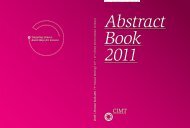Abstract Book 2010 - CIMT Annual Meeting
Abstract Book 2010 - CIMT Annual Meeting
Abstract Book 2010 - CIMT Annual Meeting
Create successful ePaper yourself
Turn your PDF publications into a flip-book with our unique Google optimized e-Paper software.
053 Stolle | Cellular therapy<br />
Generation of HCMV-/TAA-bispecific human T cells by<br />
either the genetic equipment of HCMV+ T cells with<br />
tumor-reactive TCRs or the combined retroviral transduction<br />
of bulk human T cells with HCMV-/TAA-specific TCRs<br />
Diana Stolle 1 , Beate Hauptrock 1 , Hakim Echchannaoui 1 , Edite Antunes 1 , Simone Thomas 1 ,<br />
Sebastian Klobuch 1 , Wolfgang Herr 1 , Matthias Theobald 1 , Ralf-Holger Voss 1<br />
1 Department of Hematology & Oncology, University Medical Center, Mainz, Germany<br />
Immune suppression after allogeneic stem cell<br />
transplantation causes reactivation of human cytomegalovirus<br />
(HCMV) and comes along with increased<br />
mortality in HCMV positive patients. The<br />
aim of cellular immunotherapy is the eradication<br />
of tumor cells and the decrease of the HCMV viral<br />
load by adoptive transfer of HCMV-/tumor associated<br />
antigen (TAA)-bispecific T lymphocytes.<br />
Therefore, we performed two different strategies:<br />
First, we generated HCMV-reactive (HCMV+) T<br />
cells from seropositive human blood donors using<br />
pp65(NLVPMVATV(495-503)) peptide-specific stimulation.<br />
In this case one or two restimulations<br />
led to the efficient accumulation of up to 80 %<br />
HCMV-specific T cells. To obtain a pure HCMV T<br />
cell culture we sorted the cells with CMV pp65specific<br />
streptamers by flow cytometry. Cytotoxicity<br />
was assessed in a 51-Chromium release assay<br />
using either pp65- loaded K562-A2 or HCMV-infected<br />
HLA-A*0201+ human fibroblasts as target<br />
cells. For distinct HCMV+ donors, minimal pp65<br />
peptide concentrations were in the range of as low<br />
as 0.03 nM to 100 nM triggering specific lysis at<br />
CD8+ HCMV+ to target ratios of 5:1 up to 20:1.<br />
They were indicative of high TCR affinities for the<br />
cognate antigen reflected by EC50-values ranging<br />
from 0.1 nM to 1.8 nM in peptide titration. Most importantly,<br />
HCMV T cells were efficiently capable of<br />
lysing CMV-infected human fibroblasts. After their<br />
antigen-specific expansion, HCMV-reactive T cells<br />
were equipped with a p53- or gp100- tumor anti-<br />
genspecific TCR by either RNA transfection or retroviral<br />
transduction. RNA electroporation yielded<br />
the generation of p53- as well as gp100- bispecific<br />
HCMV+ T cells: Both subsets proved efficient<br />
bifunctionality in CTL-assay and IFNg-Elisa after<br />
endogenous (pp65)- or exogenous (p53/gp100)<br />
peptide-specific stimulation. Preliminary data indicated<br />
that in retroviral transduction either TCR,<br />
the endogenous TCR CMV or the introduced TCR,<br />
are prone to be down-regulated dependent on the<br />
particular HCMV/TAA TCR combination.<br />
Our second approach was the simultaneous retroviral<br />
transduction of bulk human T cells with a<br />
HCMV- as well as p53 tumor antigen- specific TCR.<br />
Both retroviral TCR constructs contained drug selection<br />
cassettes which allowed for a normalization<br />
of TCR expression. In tetramer analysis, we<br />
were able to detect both, single TCR+ T cells and a<br />
substantial fraction of HCMV/TAA double TCR+ T<br />
cells. Endogenous TCRs were still present. Bifunctionality<br />
was corroborated in CTL-assays and in intracellular<br />
IFNg secretion stainings for specifically<br />
restimulated T cells.<br />
In summary, our data demonstrate two opportunities<br />
to generate virus (HCMV) and tumor antigen<br />
bispecific human T cells. Most importantly, the<br />
expression level of the HCMV- as well as tumor<br />
antigen- specific TCR is sufficient for specific<br />
antigen recognition.<br />
97



